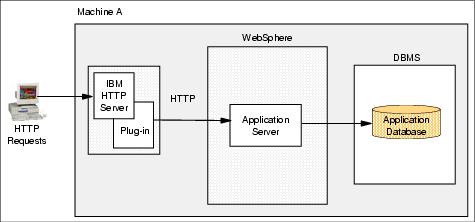Single machine topology
The starting scenario for our discussion about topologies is the configuration where all components reside on the same machine, as shown in Figure 3-4. The Web server routes requests, as appropriate, to the WAS on the same machine for processing.

Figure 3-4 Single machine topology
Some reasons to use a single machine topology are:
- Maintainability: easy to install and maintain
This configuration is most suitable as a startup configuration in order to evaluate and test the basic functionalities of WebSphere and related components. The installation is automated by tools supplied with the WebSphere distribution. This configuration is also the easiest to administer.
- Performance, security and availability are not critical goals
This may be the case for development, testing, and some intranet environments. We are limited to the resources of a single machine, which are shared by all components.
- Low cost
Consider the following when you use a single machine topology:
- Performance: components' interdependence and competition for resources
All components compete for the shared resources (CPU, memory, network, and so on). Since components influence each other, bottlenecks or ill-behaved components can be difficult to identify and remedy.
- Security: no isolation
There is no explicit layer of isolation between the components.
- Availability: single point of failure
This configuration is a single point of failure.
WebSphere is a trademark of the IBM Corporation in the United States, other countries, or both.
IBM is a trademark of the IBM Corporation in the United States, other countries, or both.